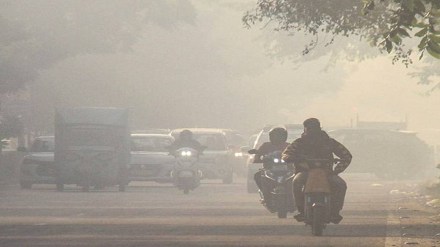Residents of Delhi woke up once again on Wednesday morning to a thick layer of smog suffocating the city. The air quality has continued to drop since the Diwali celebrations, with the average Air Quality Index (AQI) reaching 345 at 5:30 am on October 22, according to data from the Central Pollution Control Board (CPCB).
Delhi’s AQI two days after Diwali
The current AQI of Delhi falls under the “very poor” category, and the second consecutive day of severely polluted air in the national capital. On Tuesday, October 21, many parts of Delhi recorded AQI levels above 500, after the Supreme Court relaxed its blanket ban on firecrackers and residents across the National Capital Region openly violated the guidelines. The city’s 24-hour average AQI was at 351 on Tuesday, an increase from 345 on Monday, and a constant deterioration in air quality since the festival.
#WATCH | The Air Quality Index (AQI) around the India Gate was recorded at 362, in the 'Very Poor' category, in Delhi this morning as per the Central Pollution Control Board (CPCB).
— ANI (@ANI) October 22, 2025
Visuals from the India Gate pic.twitter.com/YZVqnUo5LG
Region-wise Air Quality Index
Air quality levels varied across different parts of the capital on Wednesday morning, though most areas continued to fall in the very poor to severe range. Areas like Ashok Vihar, Bawana, and Dilshad Garden recorded some of the worst pollution levels, with AQI readings at around 380 at 6:15 AM.
However, localities like Delhi Technological University (DTU), IGI Airport, and Lodhi Road stayed below the 300 mark, which falls under the “poor” category. Other stations across the city remained between 300 and 400 AQI.
On October 22, out of the 38 monitoring stations in the city, 34 were in the red zone. Two areas, Punjab Bagh and Wazirpur, were in the severe category, with AQI readings of 433 and 401, respectively. At ITO, the AQI was recorded at 361, and visuals from ANI show a thick layer of smog over the area.
For context, an AQI of 0–50 is considered good, 51–100 satisfactory, 101–200 moderate, 201–300 poor, 301–400 very poor, and 401–500 severe.
The court’s October 15 order permitted the use of green crackers in Delhi-NCR between 8 pm and 10 pm on Diwali, and from 6 am to 7 pm the day before.
Gurgaon AQI in the last 24 hrs
Over the past 24 hours, Gurgaon experienced fluctuations in air quality. The highest AQI was recorded at 593 at 11 pm, while the lowest reading of 171 was noted at 4 pm. during the day, remaining in the poor category. In different parts of Gurugram, the Vikas Sadan area showed an AQI of 246 (poor), Sector-51, Samaspur reached 392 (very poor), and Sector-2 IMT, Manesar recorded 271 (poor). Nearby areas in Delhi were also affected, with Aya Nagar in South Delhi registering 344 AQI (very poor). On the other hand, Amity University, Panchgaon, Fazalwas recorded a much lower AQI of 73, which falls under the satisfactory category.
Noida’s AQI in the last 24 hrs
In the last 24 hours, Noida experienced the highest AQI, reaching 586 at 11 pm, while the lowest reading of 168 was recorded at 4 pm during the day, still falling in the poor category. Across different areas, Sector-1, Mayur Vihar registered an AQI of 253 (poor), Sector-62 recorded 290 (poor), and Sector-125 had 282 (poor).
